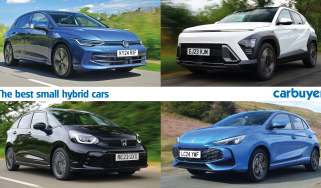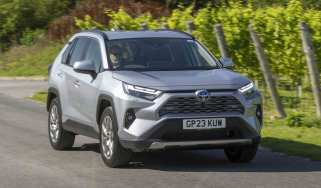2023 Toyota Corolla: Pricing, details and prototype drive
The Japanese brand’s hybrid Corolla hatchback gets more power and an improved infotainment system
- New 10.5-inch infotainment system
- More-powerful hybrid powertrains
- Due on sale early 2023
The world’s best-selling car of all time, the Toyota Corolla, has received a mild facelift for 2023. The popular hybrid hatchback gets subtle styling updates, as well as engine power hikes and a larger infotainment touchscreen.
 Top 10 best hybrid family cars 2024
Top 10 best hybrid family cars 2024
The updated Corolla will now start from £29,610 for the entry level Icon specification, and rise to £36,260 for the top specification Excel model in Touring Sports estate form. The new prices have taken immediate effect for all new orders, with deliveries of the updated model expected in early 2023. The uplift in price keeps the Toyota Corolla competitive against other hybrids, although the similarly-sized Vauxhall Astra starts from £24,665 with a regular petrol engine.
The GR Sport model doesn’t add any additional power over the other models; there’s a purposeful styling package with larger wheels, deeper bumper vents and spoilers. Prices range from £32,390 to £35,580 depending on which engine and body style is chosen. The Design model is likely to be one of the more popular trims, building on the Icon trim with upgraded 17-inch alloy wheels, bi-LED headlights, and rain-sensing wipers. There’s also an option to add a panoramic roof and prices for the Design trim range between £31,180 and £34,260.
The 2023 Corolla model will retain its ‘self-charging’ hybrid, but with increased power outputs: both the 1.8-litre and 2.0-litre hybrid models will see gains of around 15bhp. Both engine options retain a CVT automatic gearbox and are only available with front-wheel-drive.
Toyota is yet to release fuel economy figures for the updated Corolla, but we expect the new model to be just as economical as the outgoing car. Toyota is targeting a reduction in CO2 figures for the 2.0-petrol self-charging hybrid, dropping to 107g/km, while the 1.8-litre self charging hybrid will likely retain its 102g/km figure, despite its increased power output.
2023 Toyota Corolla design
The changes for the 2023 Corolla don’t just lie under the bonnet, as the new car has received several minor styling updates. The mesh grille now adopts a different design, plus there’s a new set of LED headlights with a refreshed light signature. Buyers can choose from a range of new paint colours, while GR Sport cars get a more aggressive bodykit and new 18-inch alloy wheels.
One thing that often dated the now-three-year-old Corolla was its infotainment system. Toyota intends to fix this for the mid-life update, however, as the new car gets a larger 10.5-inch central touchscreen that benefits from voice control functionality. The old semi-digital instrument cluster has also been ditched in favour of a more-contemporary 12.3-inch full-screen setup. This can be customised via four different preset ‘themes’: Casual, Smart, Sport and Tough.
Toyota intends to introduce its latest ‘T-Mate’ safety package, bringing advanced safety features, including blind spot monitoring, and accelerator suppression for sudden heavy throttle movements at low speeds. These functions will be kept fresh with over-the-air updates. The system also has a safe exit mode, which looks out for cyclists or vehicles approaching when a car door is opened, and triggers a warning.
2023 Toyota Corolla prototype drive

With over 50 million examples sold across nearly six decades, the Toyota Corolla has long been the Japanese car giant’s best-selling model. However, with the recent SUV craze, interest is beginning to slip, with buyers favouring more fashionable SUVs such as the Yaris Cross and RAV4.
Nonetheless, the Corolla remains one of Toyota’s strongest models and an update for 2023 aims to revitalise the slowly waning interest in the family hatchback segment. Although relatively minor on paper, these small tweaks to the tried-and-tested Corolla formula could go a long way to increase the model’s appeal over its crossover cousins. We’ve got behind the wheel of a pre-production model to find out whether Toyota has been successful.
At first glance, the untrained eye may struggle to see what’s new for this mid-life update of the twelfth generation Corolla. In all honesty: not much visually. There is a slightly different grille design that will certainly grab the attention of Toyota anoraks, plus a sleeker set of LED headlights that go a surprisingly long way to making the car feel a bit more premium. Otherwise, some new alloy wheel designs and a couple of new paint options are the only other distinguishable differences.
Stepping inside, the changes are a lot more obvious. There’s a new digital instrument cluster instead of the outgoing model’s old-fashioned analog dials (standard of mid-level trims and above), as well as a new 10.5-inch infotainment system that is much more responsive than before. The new Corolla also introduces Toyota’s new ‘T-Mate’ system that includes a swiss army knife of safety features such as Safe Exit Assist. This uses the variety of sensors around the car to stop you opening your door into an oncoming pedestrian or cyclist.
The greatest advancements lie under the bonnet, however, as the technical wizards at Toyota have fiddled with the Corolla’s powertrains to squeeze out a bit more performance. The entry level model now produces 134bhp, while top-of-the-range Corollas output 193bhp. This means an increase across the board of around 15bhp – but what effect does that have?

More than you might expect, actually. We got to drive the entry-level 1.8-litre four-cylinder hybrid model and while it is still no Toyota GR Yaris in terms of performance, the extra kick means that it isn’t so much of a necessity to pay extra for the more powerful engine. The new car can manage 0-62mph in a nippy 9.2 seconds – 1.7 seconds faster than before – while the punchier 2.0-litre model can do the sprint in just 7.5 seconds.
Yet, despite this increase in power, Toyota claims that it has come at no detriment to fuel economy. One of the main reasons to choose a Corolla over its rivals is the rock-bottom running costs; even during our prototype drive of the updated 1.8-litre car, we were able to return a frugal 57mpg. Of course, the more powerful 2.0-litre model won’t be quite as efficient, however lighter-footed drivers may be able to come close to this number.
The car we drove was said to be “90% percent finished”, bar some tweaks to the chassis. Overall, the ride feels just as refined and comfortable as before, with the quietness of the car’s powertrain almost coming close to that of a full EV. While lacking any real excitement or steering feel, the Corolla remains planted through twisty bends and does not suffer from much body roll.
In summary, though ostensibly minor, the updates to the new Corolla have been largely successful in increasing the car’s appeal. The fact that the larger 2.0-litre model is no longer a requirement means that the Corolla will appeal to both company car drivers and private buyers alike. This, alongside a much-slicker infotainment system has not only made the Corolla an attractive alternative to an SUV, but any other family car in general.
Can’t keep up with rising fuel costs? Check out our list of the top 10 best cheap-to-run-cars
Recommended

Citroen C4 and e-C4 get a striking redesign and big price cut for 2025
Most Popular

New Honda Prelude coming in 2026 with hybrid tech and simulated gear shifts

Best new car deals 2024: this week’s top car offers
Tips & advice

Car dashboard warning lights: what does each symbol mean?

Electric car charging stations: public networks, charger types, apps and maps












